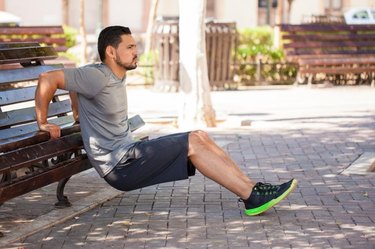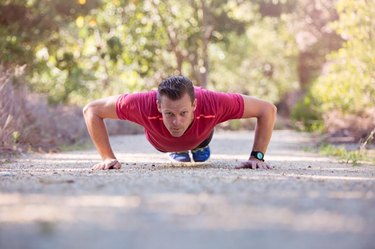
Choosing an exercise routine when you're on a tight schedule means picking exercises that give you the most bang for your buck. So, what's better; the classic push-up, or advanced exercises like chest dips and bench dips?
These enduring exercises target several muscle groups for a great upper body workout. Each exercise is simple to perform anywhere using just your body weight, but the benefits of each exercise depend on the muscles you're looking to target. Choose your exercise based on your fitness goals.
Video of the Day
Video of the Day
The Perfect Push-Up
Push-ups are a staple exercise for a reason. A push-up targets your arms and shoulders, while also engaging other muscle groups in your chest, back and core. The plank position of a push-up makes it especially good for your core; this position activates your rectus abdominis, internal/external obliques, erector spinae, deltoids, latissimus dorsi and your triceps. A core workout is a great reason to choose a push-up over a dip exercise.
To perform a perfect push-up, start in the plank position with your palms flat on the floor underneath your shoulders, and your feet together. Lower your body until your elbows are at 90 degrees, keeping your back straight and your weight evenly distributed. Then, carefully lift yourself back to the starting position.
Read More: What Muscles are Used in Push-Up Exercises?
The Perfect Dip
Dips are a more advanced workout, and are especially good for targeting the triceps. There are two primary variations of the dip. A bench dip uses a workout bench as a brace, so you can lower your body in the sitting position. A chest dip uses parallel bars as a brace, allowing you to dip in place while letting your legs hang freely beneath you.
To perform a perfect bench dip, brace yourself in the sitting position using a workout bench, with your arms slightly behind your hips. Keep your head and torso upright, and your elbows tucked in. Lower yourself below the edge of the bench, until your elbows are at 90 degrees, and then bring yourself back to the starting position.
For a perfect chest dip, mount the parallel bars with your arms locked, and your legs dangling freely beneath you, with your knees bent. With your chest and head erect, slowly lower your body straight down, with your elbows slightly flared. Carefully lift yourself back to the starting position once your elbows reach 90 degrees.
Read More: What Muscles Do Dips Work Out?
Dips vs. Push-Ups
Dips and push-ups are different exercises, and target different muscles. It's difficult to compare the two directly. However, fitness research conducted by the American Council on Exercise (ACE) in 2012 found a higher level of muscle activation for dips than for push-ups, when compared against a range of exercises.
In a separate ACE study published in 2011, dips were also found to be a very effective triceps exercise, although they were surpassed by the advanced triangle push-up variation.
So, which exercise is best? Depending on your fitness goals, the higher muscle activation of a dip will net bigger chest and arm musculature over time.

Advantages of Push-Ups and Dips
Each exercise has benefits that might make it a perfect fit for your fitness goals. Dips are the better choice when you're looking to target very specific muscles; it's an ideal exercise for your triceps, the pectoralis major, anterior deltoids and the trapezius, which acts as a stabilizer. Getting a strong chest and strong shoulders may happen faster with a dip routine than with push-ups alone. The higher muscle activation of a dip can give greater gains over a shorter period of time.
Push-ups are easily modified by your hand placement or body angle, increasing or decreasing the difficulty level and the muscles you'll engage. This makes the push-up a more versatile exercise than a dip for total-body fitness. You can also perform a push-up anywhere, without a bench or parallel bars, which can be an advantage for exercising throughout your day. The plank position of a push-up is also core strengthener, giving you a stable foundation for many other exercises and activities.
Read More: The 20 Best Bodyweight Exercises
- Harvard Health Publications: The Rise of Push-Ups: A Classic Exercise That Can Help You Get Stronger
- Men's Fitness: How To Do Dips
- The New York Times: An Enduring Measure of Fitness: The Simple Push-Up
- Muscle Mag Fitness: Tricep Dips
- American Council on Exercise: Best Tricep Exercises
- American Council on Exercise: Top 3 Most Effective Chest Exercises
- National Strength and Conditioning Association: What Is The Core and How Do You Activate It?
- FitnessUncovered.co.uk: Chest Dips